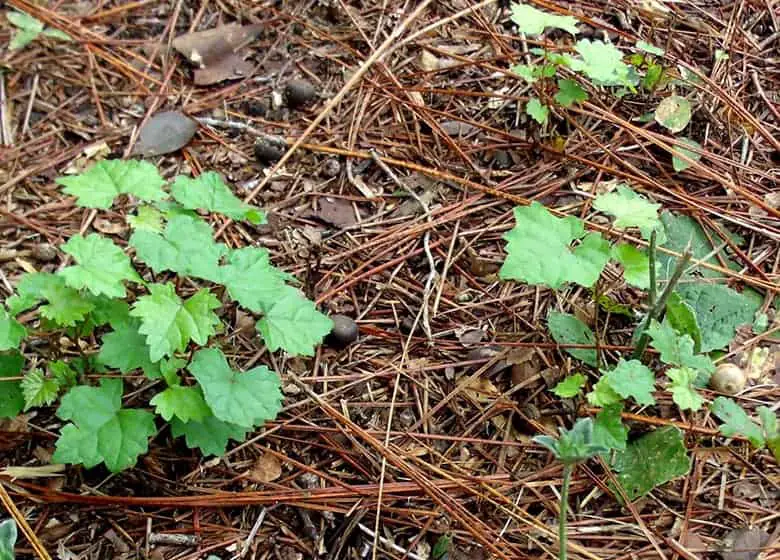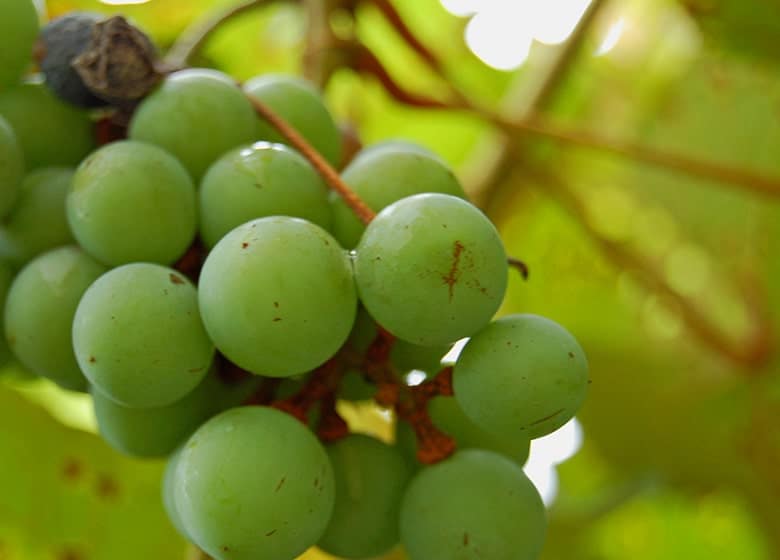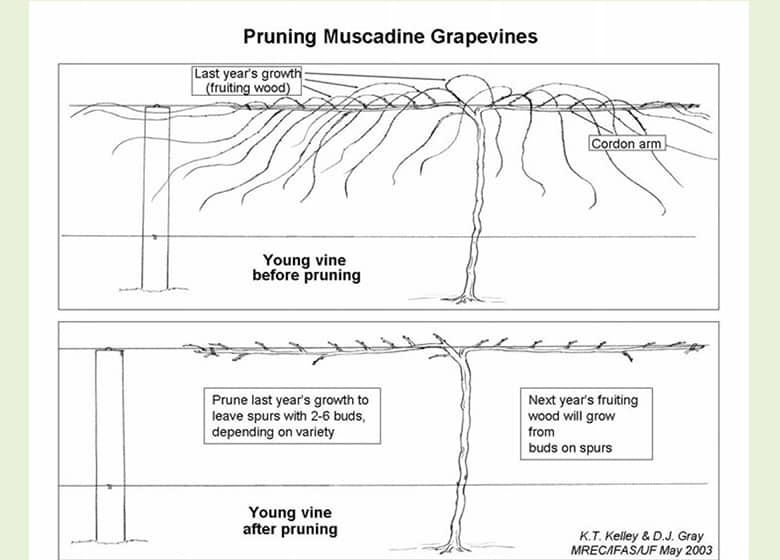Ever wondered if grapes grow well in Florida? Could I possibly grow my own wine?!
Muscadine grapes and bunch grapes are the two types of grapes that grow well in Florida. The University of Florida has bred a cross between the two called ‘Southern Home’ and it has the best characteristics of both.
The two varieties have some differences in terms of the fruit that they produce. Read on to learn varieties, planting time and care instructions.
Muscadine v. bunch
Muscadine grapes are native to Florida, so that tells you that they can be grown very easily.
These grapes are usually dark-colored and grow in bunches of between 5-30. Muscadine grapes have very thick skin. unlike a normal bunch type grape, you don’t eat the skin.
The skin on muscadine grapes is almost leathery, most people discard the skin but you can eat the skin and it actually contains a lot of the health benefits.
The tough skin helps muscadine grapes have a high disease and pest resistance.
Bunch grapes are the common grapes that you see at the store. They usually grow in much larger groups of grapes and they have much thinner skin.
Most of the bunching types of grapes are less hardy when compared to muscadine grapes.
Best Grape Varieties For Florida
Muscadine grapes are the easiest kind of grape to grow in Florida. These grapes grow in USDA zones 7 and higher while most bunching type grapes cant be grown in Zone 11. (Sorry south Florida)

Varieties of Muscadine:
- Africa Queen
- Dixie Land
- Fry
- Jumbo
- Later Fry
- Scuppernong
- Sugargate
- Supreme
- Sweet Jenny
Bunch Grape Varieties:
- Conquistador
- Black Spanish
- Blanc DuBois
- Blue Lake
- Orlando Seedless
- Suwanee
There is a grape variety that the University of Florida has given us, It’s called the ‘Southern Home’ grape and it has high disease, pest, and environmental resistance while also having the thin skin of many common bunching grapes.
It’s a cross between a couple of muscadine grapes as well as a bunching type.
It literally combines the best of both worlds. While you can use both grape types for winemaking and table munching, most people find the thick skin of the muscadine grape not as appealing.
The southern home grape is a self-pollinating variety, which means that you don’t need multiple plants in order to have fruit. Some grape types do only produce either male of female flowers, requiring you to have a couple of plants, and enough space to put them to get a harvest.
When To Plant Grapes In Florida
The best time to plant grapes is in the early springtime. These are perennial plants and can live for many years.
Planting TImes For Florida:
- North: March
- Central: February – March
- South: Anytime
Consider your area’s average last frost date. and plant as soon as any fear of frost is going to be gone. Use the above dates as a guideline and use your best judgment, your climate will change slightly from year to year.
Grapes are best planted as transplants that were started from cuttings. If planting multiple grape vines be sure to give plenty of space in between each plant.
When planting, you must dig a hole twice the size of your root ball. This loosens the soil around your plant and gives the roots a nice area to work with.
Grapes are vigours growers, bunching type grapes need about 6- 10 feet of space and muscadine grapes need about 12-15 feet in between each plant.
Best Location For Grapes
Grapes need full sun, a rich soil, and plenty of space to on.
Anywhere that gets 8+ hours of sun is ideal. Grapes can take our Florida heat and they don’t prefer to hide in the shade.
Grapes don’t like to have their feet in mucky soils or overly sandy soils. You can certainly plant right into the ground, but I will always recommend adding, at the very least, compost and a layer of mulch.
You can grow grapes in raised beds if you choose to. When building a riased bed or amending soil I like to use a mix that looks something like this:
- 40% Peat moss (Check price on Amazon)
- 40% Compost (You can get it on Amazon but I’ve found it way cheaper at local stores)
- 20% perlite (Check price on Amazon)
- Worm castings (Check price on Amazon)
- Mykos (Check price on Amazon)
Lately, I’ve been substituting coco coir for peat moss, it’s a little bit more expensive but more sustainable and less acidic. Although grapes do like slightly acidic soil so maybe peat would be better for them.
Grapes will also need something to grow on.
You can get a decorative trellis or use your chain link fence in the backyard.
Harvesting Grapes
It usually takes about 2-3 years for a grape plant to begin producing fruit. The muscadine varieties usually produce larger yields of fruit.
When grapes do begin to produce you should expect fruit to be harvested in in June and July.

Bunch grapes usually form a larger bunch of grapes though. Muscadine grape bunches can be anywhere from 5-30 grapes in a single bunch. but bunching type grapes can have bunches that are much larger than that.(Can we say the word bunch a bunch more times!)
You harvest grapes off of the new growth. So it’s important to prune your plant in order to increase your harvest.
Pruning Grapes
I found a really good picture from IFAS that shows how you should prune your grape plant in order to keep it contained and also get the most fruit.

Fruits are made form all of the new growth that will grow off of those buds that you just pruned down.
If you want a grape plant with more than one main stem you can also prune it that way. You can train your plant to grow up a trellis and then spread out to multiple vines if you wanted. This might work if you’re trying to add a little beauty in the garden, instead of just function.
The best time to prune grapes in Florida is anywhere between January to March. South Florida should be pruning closer to January while north Florida should be pruning closer to march.
Fertilizing Grapes
Grapes prefer a well-balanced fertilizer. A good solid 10-10-10, or any old organic vegetable fertilizer will do.
Each nutrient in the fertilizer does something different for the plant. the three values are the N-P-K values. Nitrogen (N), Phosphorous(P), Potassium(K).
Nitrogen promotes new green growth. Phosphorous promotes root development, flower and fruit production.
And potassium is a good general health booster.
Grapes will benefit from all of these things.
Grape Pests & Diseases
Common grape pests include aphids and beetles. While common diseases for grapes are black rot and powdery mildew.
A nice organic neem oil(Check price) sprayed on to your plant will help control many of your problems with pests and diseases.
You will probably also have to battle the birds for your fruit. Staying on top of harvesting ripe fruit is the best way to beat the birds. Just gotta be quicker than they are.
Growing Grapes In Florida
- Both Muscadine and bunching varieties of grapes grow well in Florida
- I think the best grape to grow in Florida is the ‘Southern Home’ variety. It is the best of a muscadine and a bunching type grape put into one.
- Plant in Full sun and enriched soil
- Prune and trellis your grape plant
- Fruit is produced on new growth and you should prune at the beginning of the year (Jan – Mar)
- Fertilize with a well-balanced fertilizer
- Expect fruit in the third year of growth
You might also be interested in:

